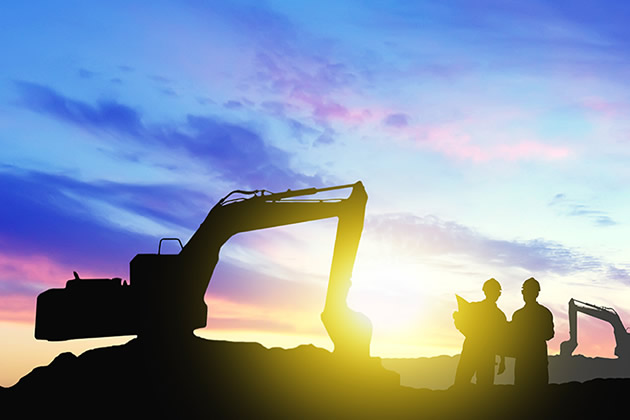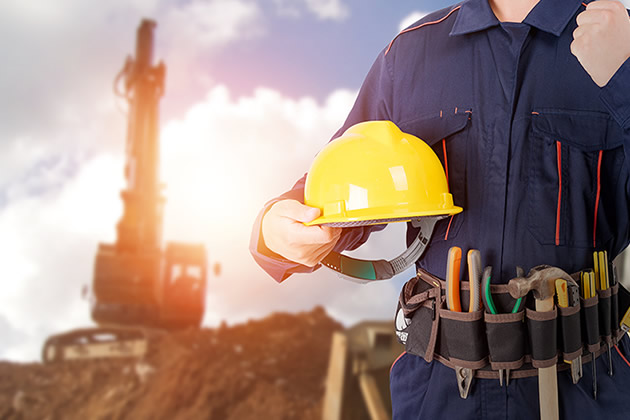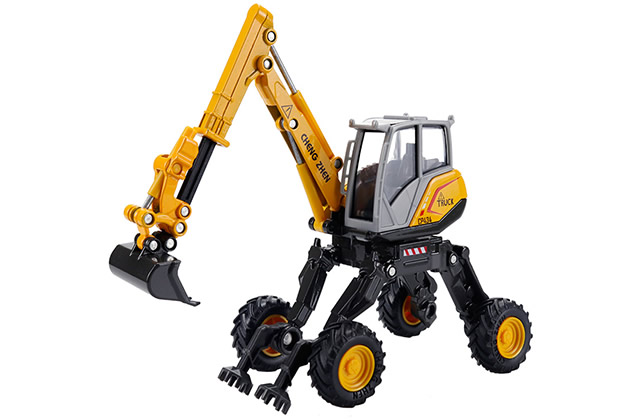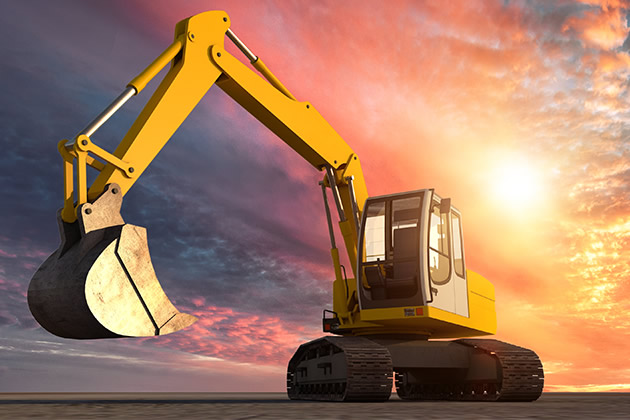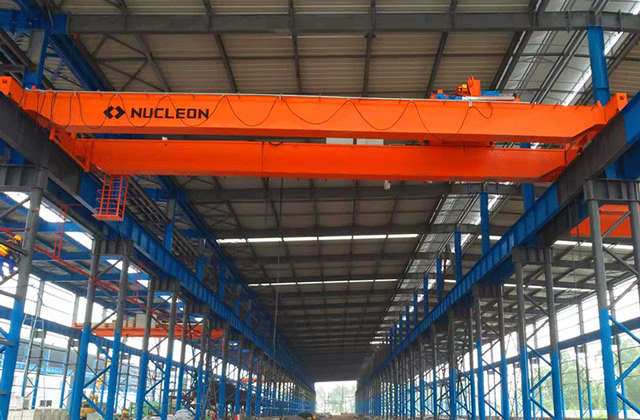Do you know the safety knowledge about the use of construction machinery and equipment?
Mechanical equipment that is in good condition and has complete safety facilities and meets the requirements of the construction site must be used. Mechanical equipment must not be maintained or repaired when in use. When a fault occurs, the machine should be shut down for repairs in time, and it is strictly forbidden to operate the mechanical equipment in a sick state.
Section 1: Safety knowledge on the use of construction hoisting machinery
The operation of tower cranes, construction elevators, material hoists and other construction hoisting machinery (also Operators such as drivers (called drivers), conductors, and rope handlers belong to special operations. They must undergo special safe operation training in accordance with relevant national regulations and obtain special operation qualification certificates before they can work on their jobs. Construction hoisting machinery (also called vertical transportation equipment) must be produced by companies with corresponding manufacturing (production) licenses and have factory certificates. The installation, dismantling, heightening and wall-attaching construction operations must be carried out by teams with corresponding operating qualifications. Operators must undergo special safe operation training in accordance with relevant national regulations and obtain special operation qualification certificates before they can work. Other non-professionals are not allowed to work.
Before installation, disassembly, heightening and wall-attaching construction operations, there must be an approved and reviewed construction plan, and a briefing on the plan and safety technology.
1. Safety knowledge when using tower cranes
1. “Ten things not to do when lifting a crane”:
⑴ Overloading or being hoisted Do not hoist the object if the weight is unclear;
⑵ Do not hoist if the command signal is unclear;
⑶ Do not hoist if the binding, hanging is not firm or unbalanced;
⑷ Do not lift if there are people or floating objects on the object to be lifted;
⑸ Do not lift if the structure or parts have defects or damage that may affect safety; Do not hoist;
⑺ Do not hoist a single steel wire;
⑻ Do not hoist when the working area is dark and cannot see the site, the objects to be hoisted and the command signal clearly;
⑼ Do not lift heavy objects without padding between corners and binding wire ropes;
⑽ Do not lift flammable and explosive items.
2. Irrelevant personnel are strictly prohibited from entering the tower crane lifting operation area, and no one is allowed to stand under the lifting objects.
3. Drivers (operators), conductors, rope handlers and other types of work should be equipped according to relevant requirements, and other personnel are not allowed to work.
4. Lifting objects is not allowed in strong winds above Level 6.
5. Operators must obey the instructions of the commander and evacuate before lifting objects.
6. Bundling requirements for hanging objects:
⑴ When lifting objects, the weight should be clear, and the lifting points and lashings should be firm and reliable;
⑵ Hoisting When transporting bulk materials, a qualified iron hopper should be used. The hopper should be equipped with a dedicated and strong lifting point; the height of the contents of the hopper should not exceed the upper edge of the hopper. Bulk materials are light and easy to transport.The height of the scattered objects should be 10cm lower than the upper edge;
⑶ When lifting long items (such as steel bars, long wooden cubes, etc.), two uniform and even Balanced lifting points and firm binding;
⑷ When lifting objects with edges and sharp edges, protective measures should be taken at the binding area of the wire rope.
2. Safety knowledge when using construction elevators
Construction elevators are also called external elevators, and also called (dual-purpose people and cargo) construction elevators. Main machinery and equipment for vertical transportation of personnel and materials on site.
1. Before the industrial elevator is put into use, an entrance and exit protective shed should be erected on the first floor. The protective shed should comply with relevant regulations for high-altitude operations.
2. The elevator must be stopped in use when there is heavy rain, heavy fog, strong winds above Level 6, or when the guide rails, cables, etc. freeze. And lower the ladder cage to the bottom floor and cut off the power supply. After a storm, each safety device of the elevator should be inspected and confirmed to be normal before use.
3. Protective railings should be installed within 2.5m around the ladder bottom cage.
4. The transportation platform of each outlet of the elevator should be flat and firm, and strong and reliable railings and safety doors should be installed. The safety doors should be kept closed during use.
5. There should be clear communication signals when using the elevator, and it is prohibited to use knocking, calling, etc. to communicate.
6. When taking the elevator, you should close the safety door first, then close the ladder cage door before starting the elevator.
7. When people or objects are loaded in the ladder cage, the load should be evenly distributed and should not be too heavy; overload operation is strictly prohibited.
8. When waiting for the elevator, you should stand inside the building and do not gather on the passage platform or extend your head and hands outside the railings and safety doors.
9. When the elevator runs with load for the first time in each shift, when the ladder cage is raised 1~2m above the ground, it should be stopped to test the reliability of the brake; when the braking effect is found to be poor, it should be adjusted or repaired before proceeding. Put into use.
10. Operators should operate according to command signals. Sound the signal before starting work. The operator shall not leave the operating position before the main power switch of the elevator is turned off.
11. Treatment of construction elevator failures
⑴ When an abnormality is discovered during operation, the machine should be stopped immediately and effective measures should be taken to lower the ladder cage to the bottom floor and the fault should be eliminated before proceeding. Continue to run;
⑵ When electrical out-of-control is found during operation, the emergency stop button should be pressed immediately; the emergency stop button must not be opened before the fault is eliminated;
⑶ During operation When a brake failure is found, the ladder cage can be opened to the bottom for repairs; or the ladder cage can be slid down and braked by the anti-fall safety device;
⑷ When a fault is found during operation, do not panic, the elevator’s safety device will provide reliable protection; and follow the arrangements of dedicated personnel, or wait for repairs, or evacuate according to professional instructions.
12. After the operation, the ladder cage should be lowered to the bottom, all control switches should be set to zero, the power supply should be cut off, the switch box should be locked, and the ladder cage door and enclosure should be closed.Guard the door.
3. Safety knowledge when using material hoists
Material hoists are available in gantry and tic-tac-toe types, and some are also called (cargo) Construction elevators are the main mechanical equipment for vertical transportation of materials on construction sites.
1. The material hoist is used to carry materials, and it is strictly prohibited to carry people up and down; loading and unloading personnel and maintenance personnel must have reliable safety devices or take reliable measures before they can enter the cage to work.
2. The inlet of the material elevator must be equipped with a safety protective door, and a protective shed must be erected in accordance with the regulations for high-altitude operations, and a safe passage must be provided to prevent entry into the frame from outside the shed.
3. When the material hoist is in operation, maintenance and repair of the equipment is strictly prohibited, and no one is allowed to climb or pass through the frame.
4. Requirements for transporting materials
⑴ When transporting bulk materials, hoppers should be used to load them and placed stably; when using hand-bucket trucks to install in cages, handles must be installed Place the push truck stably and brake, and be careful that the handle and the cart cannot extend out of the cage;
⑵ When transporting long materials, the materials must not exceed the cage; when the materials are placed vertically, they should be tied firmly;
⑵ p>
⑶ When loading materials, they should be evenly distributed and should not be too heavy. Overloading is strictly prohibited.
5. The frame of the material hoist should be attached to the wall or cable wind rope, and should be strong and reliable, and comply with the requirements of the instructions and specifications.
6. The outside of the material elevator frame should be closed with a small mesh safety net to prevent materials from falling during operation.
7. It is prohibited to weld, cut or drill on the material lifting frame to prevent damage to any components of the frame.
8. The outlet platform should be strong and reliable, and protective railings and safety doors should be installed. The safety door should remain closed during operation.
9. There should be a safety door on the hanging cage to prevent materials from falling; and the safety door should be interlocked with the safety docking device. Safety docking devices should be sensitive and reliable.
10. The floor safety door should be equipped with an electrical or mechanical lock device to restrict the operation of the cage when the safety door is not reliably closed.
11. When workers are waiting for the cage, they should wait more than 1m away from the safety door inside the building materials or on the platform. It is strictly prohibited to extend your head and hands beyond the railing or safety gate.
12. Clear communication signals should be installed at the material inlet and outlet, and the overhead hoist should also have a visual system.
Section 2: Safety knowledge in hoisting operations
Hoisting refers to the use of corresponding mechanical equipment and facilities to complete structural hoisting in construction projects and facility installation. The operation is dangerous, the operating environment is complex, and the technology is difficult.
1. Before the operation, a special construction plan should be prepared according to the characteristics of the operation, and the plan and safety technology should be explained to the personnel participating in the operation.
2. A warning area should be set up around the operation, and eye-catching warning signs should be set up to prevent irrelevant personnel from entering; particularly dangerous areas should be monitored.nursing staff.
3. Most lifting and hoisting operations must be performed by professional and technical personnel; personnel involved in special operations must undergo special safety operation training in accordance with relevant national regulations and obtain special operation qualification certificates. On-the-job work.
4. Operators should choose a safe location to operate based on on-site operating conditions. It is prohibited for people to stand or pass in the area where the hoist and ground pulley pass through the wire rope.
5. The hoisting process must be directed by a dedicated person, and other personnel must obey the command. Lifting command cannot also be used as other types of work. And should ensure that the lifting driver hears the command signal clearly and accurately.
6. During the operation process, the principle of “ten don’t lifts” of the crane must be followed.
7. The requirements for bundling the hoisted objects are in accordance with the requirements for bundling the hoisted objects in the tower crane in Section 1.
8. The storage area for components should be flat and solid. The stacked components should be flattened with square wood, which must be stable and not allowed to be super high (generally it should not exceed 1.6m). In addition to providing spacers for component storage, corresponding supports must be provided when necessary to improve their stability. It is prohibited for unrelated personnel to walk through the stacked components to prevent collapse of components and crowding accidents.
9. Lifting and hoisting operations should be stopped when there are strong winds above Level 6 or heavy rain, heavy snow, fog, etc. in the open air.
10. When the crane is operating, no one is allowed to stay, work or pass under the boom and hoisted objects. When lifting heavy objects, it is strictly prohibited for people to pass from above. It is strictly forbidden to use cranes to transport people.
11. Precautions for frequently used lifting tools.
⑴ Manual reversing chain: The operator should be trained and qualified before the owner can start the work. When lifting objects, the reversing chain should be pulled slowly after hanging it securely, and should not be pulled diagonally. When one person cannot pull, the reason should be identified and multiple people should not pull at the same time.
⑵ Manual hoist: The operator should be trained and qualified before the owner can work. Check the reliability of the self-locking clamp device before use. After clamping the wire rope, it should be able to reciprocate, otherwise it is prohibited. use.
⑶ Jack: The operator should be trained and qualified before the owner can start working. The jack should be placed on a flat and solid ground, and should be padded with wooden boards or steel plates to prevent ground subsidence. The contact surface between the top and the smooth object should be padded with hard wood to prevent sliding. At the beginning of the operation, you should gradually lift up, pay attention to prevent the lifting from tilting, and always maintain the balance of the heavy object.
Section 3 Common sense on safety in the use of small and medium-sized construction machinery
The use of construction machinery must be carried out according to the “fixed personnel and fixed machines” system. Operators must be trained and qualified before they can start working, and other personnel are not allowed to use it without authorization. Before the machinery is used, all parts of the machinery and equipment must be inspected to confirm that they are intact; and a trial run without load must be carried out to meet the safety technical requirements before use.
The mechanical equipment at the construction site must be equipped with control equipment that meets the regulations according to its control requirements. The use of reverse switches is strictly prohibited. When using mechanical equipment, safety operating procedures must be strictly followed, and illegal operations are strictly prohibited;If there is any malfunction, abnormal noise, or abnormal temperature rise, it must be shut down immediately; it can only be put into use again after it has been repaired by professionals and passed the inspection.
Operators should meet the cross-operation requirements of “adjustment, tightening, lubrication, cleaning, and anti-corrosion” and maintain mechanical equipment according to relevant requirements. Operators are not allowed to leave their jobs without authorization while working. When leaving get off work, you should first stop the machine, then disconnect the power supply and lock the electrical box before leaving.
1. Concrete (mortar) mixer
1. The installation of the mixer must be stable and firm. For long-term fixed use, anchor bolts should be embedded; for short-term use, wooden sleepers or braces should be laid on the base to level and securely place it.
2. When the hopper is lifted, it is strictly prohibited to work or walk under the hopper. When cleaning the hopper pit, you must first cut off the power supply, lock the electrical box, and hang the double safety hooks of the hopper or insert the safety bolt.
3. During operation, it is strictly prohibited to put your head or hands between the hopper and the frame for inspection, and you are not allowed to use tools or objects to extend into the mixing drum.
4. Maintenance and repairs are strictly prohibited during transfer. When repairing and maintaining the mixer, the power must be turned off, the electrical box must be locked, a sign saying “No closing of the switch when someone is working” must be hung, and there must be a dedicated person to supervise the mixer.
2. Concrete vibrator
Commonly used concrete vibrators include plug-in type and flat type.
1. The vibrator should be equipped with a leakage protection device, and the protective zero connection should be firm and reliable. Operators should wear insulating rubber shoes and insulating gloves when working.
2. Before use, check that all parts are free of damage, and confirm that the connection is firm and the direction of rotation is correct.
3. The cable should meet the length required for operation. Do not use cables to drag or hang the vibrator. The vibrator shall not be used for vibration testing on initially set concrete, floors, scaffolding and dry hard ground. During maintenance or interruption of operations, the power supply should be disconnected.
4. During operation, the bending radius of the vibrator hose shall not be less than 500mm, and shall not be more than two bends. During operation, the vibrator shall be sunk vertically into the concrete, and shall not be forced or pushed diagonally. Or let the steel bar clamp the rod head, and it is not allowed to be completely inserted into the concrete. The insertion depth should not exceed 3/4 of the length of the rod, and it is not suitable to touch the steel bars, core pipes and embedded parts.
5. When the vibrator needs to be moved when the operation is stopped, the motor should be turned off first, and then the power supply should be cut off. Do not use a hose to pull the motor.
6. When the flat-plate vibrator is working, the flat plate should be kept in contact with the concrete. After the slurry is released on the surface and no longer sinks, it can be moved slowly; when operating, it should not be left on the set or initial stage. on solid concrete.
7. Use dry and insulated pull ropes when moving flat vibrators, and do not kick the motor with your feet.
3. Steel bar cutting machine
1. When the machine does not reach the normal speed, no cutting is allowed. When cutting, use the middle and lower parts of the cutterposition, hold the steel bar tightly and align it with the cutting edge and quickly throw it in. The operator should stand on the side of the fixed blade and press the steel bar hard to prevent the end of the steel bar from popping out and injuring people. It is strictly forbidden to hold the steel bar on both sides of the blade with both hands and bend the flute to feed.
2. Do not cut steel bars whose diameter and strength exceed those specified on the machine nameplate and red-hot steel bars. When cutting multiple steel bars at one time, their total cross-sectional area should be within the specified range.
3. When cutting short materials, the distance between the hand and the cutter should be kept above 150mm. If the hand grip end is less than 400mm, a sleeve or clamp should be used to press or clamp the short end of the steel bar. prison.
4. It is strictly forbidden to use hands to directly remove broken ends and debris near the cutter during operation. Non-operators are not allowed to stay around the swing of steel bars and around the cutting knife.
4. Steel bar bending machine
1. The mandrel and forming shaft of corresponding specifications should be installed according to the diameter and bending radius of the processed steel bar. , retaining iron shaft. The mandrel diameter should be 2.5 times the diameter of the steel bar. The iron retaining shaft should have a sleeve, and the diameter and strength of the iron retaining shaft should not be less than the diameter and strength of the bent steel bar.
2. During operation, the bent end of the steel bar should be inserted into the gap of the turntable fixed pin, the other end should be close to the fuselage fixed pin, and pressed by hand; the fuselage fixed pin should be checked and confirmed to be placed. It can only be operated on the side blocking the steel bars.
3. During operation, it is strictly prohibited to replace the shaft core, pins, angle changes and adjustments, and cleaning and refueling are not allowed.
4. It is strictly forbidden to bend steel bars that exceed the diameter specified on the machinery nameplate. Rebar that is not straight must not be bent on the bending machine.
5. It is strictly prohibited to stand within the working radius of the bent steel bars and on the side of the fuselage without fixed pins.
6. When changing the direction of the disk, wait until it has stopped.
7. After operation, rust, debris, etc. in the turntable and the insertion hole should be promptly removed.
5. Steel bar straightening and cutting machine
1. The appropriate straightening block and transmission speed should be selected according to the diameter of the straightening steel bar. The hole diameter of the straightening block should be 2~5mm larger than the diameter of the steel bar. The transmission speed should be selected according to the diameter of the steel bar. For larger diameters, slow speed should be used. Only after passing the debugging can it be operated.
2. Do not feed materials before the straightening block is fixed and the protective cover is not covered. It is strictly prohibited to open each protective cover and adjust the gap during operation.
3. After the steel bar is fed in, the hand and the wheel should keep a certain distance and should not get close.
4. The ends of the steel bars that are not straight should be cut off before feeding. A 1m long steel pipe should be installed in front of the guide tube, and the steel bar should pass through the steel pipe and then be fed into the guide hole at the front end of the straightening.
6. Steel bar cold drawing machine
1. The position of the winch should allow the operator to see the entire cold drawing site, the winch and the cold drawing center line The distance shall not be less than 5m.
2. Warning zones should be set outside the ground anchors at both ends of the cold-drawn site, and protective guards should be installed.Guardrails and eye-catching warning signs. Non-operating personnel are strictly prohibited from staying here. Operators must stay 2m away from the steel bars when working.
3. The winch operator must see the signal sent by the commander and wait until all personnel leave the danger area before operating. Cold drawing should be slow and even. When there is a stop signal or the wind causes someone to enter the danger zone, stop pulling immediately and slightly relax the winch wire rope.
4. Lighting facilities for night operations should be installed outside the tension danger zone. When it needs to be installed above the site, its height exceeds 5m. The light bulb should be covered with a protective cover.
7. Circular Saw
1. The saw blade must be flat and the teeth must be sharp. There must not be two missing teeth in a row, and the length of the crack must not exceed 20mm.
2. The thickness of the sawn wood is limited to 10~20mm that the saw blade can expose the wood.
3. After starting, you must wait for the speed to be normal before sawing.
4. When closing the material, do not shake the wood from left to right or lift it high. Feed the wood slowly when there are knots in the wood. The length of saw material shall not be less than 500mm. When approaching the end, the push rod should be used to feed the material.
5. If the saw wire goes astray, it should be corrected gradually and not sharply.
6. The operator should not stand on the same straight line as the saw blade. Do not work with arms across the saw blade.
8. Frog-type tamping machine
1. During the tamping operation, one person should hold the tamping force and one person should pass the cable. Insulating gloves and gloves must be worn. Insulated shoes. Cables must not be twisted or twisted, and must not be stretched too tight. There should be a margin of 3~4m. When moving, the cables should be moved to the rear of the rammer, and the cables should not be thrown across the machine. When the steering is difficult, the machine should be stopped for adjustment.
2. When working, hold the handrail to keep the body balanced, do not press backwards hard, and adjust the direction of travel at any time. Do not use excessive force when turning, and do not make sharp turns.
3. When compacting and filling high earthwork, compact 2 to 3 times within 100~150mm of the edge, and then compact the edge.
4. When working in a large foundation pit, tamping on a slope is not allowed to avoid causing the tamping head to fold backwards.
5. When compacting the soil in the center of the house, the tamping plate should avoid underground structures, reinforced concrete foundation piles, machine bases and underground pipes in the center of the house.
6. When working inside a building, tamping plates or eccentric blocks must not hit the wall.
7. When multiple machines are operating, the distance between the base and the rows shall not be less than 5m, and the distance between the front and rear shall not be less than 10m.
8. No non-operators are allowed to stand in the forward direction and within 1m around the rammer.
9. Vibration impact rammer
1. After the internal combustion impact rammer is started, the internal combustion engine should run at idle speed for 3~5 minutes, and then gradually increase the accelerator until the impact rammer is pressed. Operation can only be performed after the machine beats stably.
2. The electric impact rammer starts when the power is turned on.After starting, the motor rotation direction should be checked, and if there is an error, the associated wires should be reversed.
3. The rammer should be correctly controlled during operation. It should not be tilted. The handle should not be held too tightly. It is enough to be able to control the forward speed of the rammer.
4. During normal operation, do not press the handle down hard, which will affect the jumping height of the rammer. When working on loose packing or going uphill, you can press the handle down slightly, which should increase the forward speed of the rammer.
5. Electric impact rammer operators must wear insulating gloves and insulating shoes. During operation, the cable should not be pulled too tight, and the installation of the wires should be checked frequently to prevent loosening and causing leakage. It is strictly prohibited to work in the rain.
10. Submersible pump
1. The submersible pump should be installed in a strong basket before being put into the water. The pump can also be placed in the water. Set up a strong protective fence around the area. The pump should stand upright in the water, the water depth must not be less than 0.5m, and it must not be used in water containing sediment.
2. When the submersible pump is put into the water or lifted out of the water, the power supply should be cut off first, and it is strictly forbidden to pull the cable or outlet pipe.
3. The submersible pump should be equipped with zero protection and leakage protection devices. During operation, no one or livestock is allowed to enter the water surface within 30m around the pump.
4. Observe changes in water level frequently. The distance from the center of the impeller to the horizontal should be between 0.5 and 3.0m. The pump body must not sink into the sludge or be exposed to the water. The cable must not rub against the well wall or pool wall.
5. The insulation resistance of the motor stator winding should be measured once a week, and the value should not decrease.
11. AC welding machine
1. The shell must be protected from zero, and there should be a secondary no-load voltage reduction protector and electric shock protection device.
2. The power supply should use an automatic switch, and the wiring board should be undamaged and have a protective cover. The length of the primary line shall not exceed 5m, and the length of the secondary line shall not exceed 30m.
3. There must be no flammable or explosive items within 10m of the welding site.
4. No outdoor work is allowed on rainy days. When welding in a wet location, stand on a rubber sheet or other insulating material.
5. When moving the welding machine, the power supply should be cut off and the welding machine should not be moved by dragging the cable. When there is a sudden power outage during welding, the power supply should be cut off immediately.
12. Gas welding equipment
1. The distance between oxygen bottles and acetylene bottles should not be less than 5m during use, and the distance between storage time should not be less than 3m, and they should be kept away from high temperature , open flames, etc. shall not be less than 10m; when the above requirements are not met, isolation measures should be taken.
2. Acetylene bottles must be stored and used in an upright position and are strictly prohibited from being placed upside down.
3. When moving gas cylinders, special lifts or trolleys should be used; it is strictly forbidden to transport oxygen cylinders and acetylene together; it is forbidden to use wire ropes and chains directly.
4. Special tools should be used to open and close the gas cylinder.
5. It is strictly prohibited to knock or collide with the gas cylinder.Smoking is not allowed at all times.
If the website content violates your rights, please contact us to delete it。



